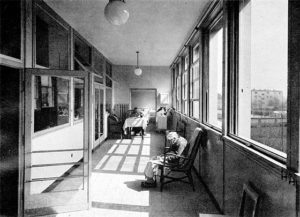Architectural History
The donations of the May siblings to the Municipality of Rödelheim
On May 20, 1874 the sons of Joseph Hirsch May and Hannchen May, Julius and Arthur May, together with their sister Rege, donated a “dwelling plus equipment for the accommodation of sick and needy people” to the Municipality of Rödelheim in memory of their deceased parents (ISG Ffm: magistrate records V 339: 1-3).
For this purpose a building with eight rooms had been erected on the property where the parents formerly had lived themselves. The building also provided a prayer room for Jewish church services facing east to the village of Hausen (cp. Trümpert 1881: 39). (See also article “Foundation History” and database entry “Institution”).
In the possession of the City of Frankfurt am Main and first renovations
When Rödelheim was incorporated into Frankfurt in 1910, the management of Rödelheim´s hospital was taken over by the local hospital (cp. Lustiger 1988: 147). Consequently, it started to increase its number of beds from 26 to 35. In the course of the renovation, the plumbing system was renewed. A hot water system and electrical lighting were installed. A light and ventilation shaft, a bathing facility as well as a new cooking plant and heating system were added. The patient rooms as well as the nurses´ station were also renovated. The cost estimate was 6,850 Marks (cp. ISG Ffm: magistrate records V 339: 10).
In the following years more properties were purchased. Single endowments like the heritage of 150 Marks of the widow Margarethe Kohlhoff née Melsoch von Friedrichsdorf i/T. in 1916 (cp. ISH Ffm: magistrate records V 339: 13) were received. During the First World War the building was also used as a military hospital (Kraft 1960).
The conversion to an infirmary and extensions
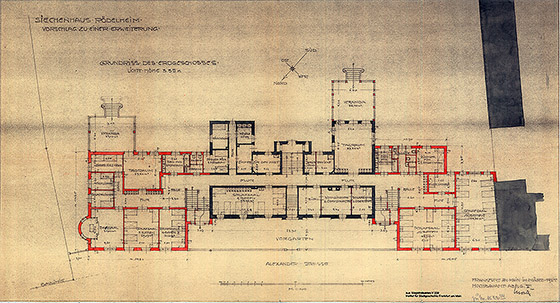
© Institute for the History of Frankfurt am Main
In 1922 the hospital changed into an infirmary, where 32 people, including 12 men and 20 women, were accommodated (cp. ISG Ffm: magistrate records V 339: 35). A greater extension was planned in 1925: “As it has become impossible to provide an appropriate accommodation for chronically sick people, we are forced to plan the extension of Rödelheim´s infirmary” (ISG Ffm: magistrate records V 339: 49). The intention was to provide accommodation for 90 patients and to increase staff by eight to ten persons and to expand the utility, bathing and living rooms. Part of the plans was also a mortuary, a new laundry as well as a lifting crane in the bathing cell for “patients having become completely crooked and stiff by gout” (ISG Ffm: magistrate records V 339: 49). The cost estimate was 250,000 Marks. In order to be able to argue for the extension, the financing authorities calculated the possible savings. Assuming the care for about 200 care dependent people who are accommodated in hospital at a daily rate of 4,50 Marks, the aim due to the discontinuation of medical care in the infirmary was to achieve a daily rate of 2.25 Marks in an infirmary. The calculated savings were 48,453.75 Marks. Moreover, there would be more free beds provided in the hospitals (cp. ISG Ffm: magistrate records V 339: 49a).
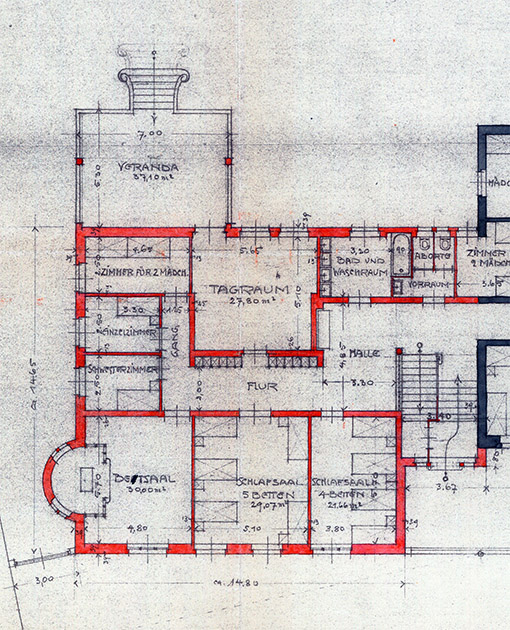
© Institute of the History of Frankfurt am Main
In 1927 the executive board of the foundation agreed to the conversion, in order to preserve – in its opinion – the foundation purpose of providing accommodation for sick and needy people (cp. ISG Ffm: magistrate records V 339: 79). The planning team added some further details such as cuspidor bowls with flushing in the corridors in order to minimize the risk of TBC-infections (cp. ISG Ffm: magistrate records V 339: 106). On the occasion of the inauguration ceremony of the extension in April 1930 both the architect Max Cetto from the group around the settlement councilor Ernst May and the magistrate building officer Weber were praised that it was thanks to their work that the old and the new building had been connected to a “uniform building structure of the utmost clarity and openness [sic] and consummate practicality in the facility. The building is decorated with clear and friendly colors, and it is well-structured by wide banks of windows” (Frankfurt News April 29, 1930). The newspaper also reported of 101 beds in 18 patient rooms with two to seven beds as well as of living rooms for men and women for 45 people each. Six large halls for recumbent patients had been created; numerous bath rooms, kitchen and laundry completed the facilities. There were ventilation systems, radio in the whole house with loudspeakers in the living rooms and headphones at each bed. And the home was already fully occupied at a daily care rate of 2 Reichmarks (cp. Frankfurt News April 29, 1930).
Damages during the Second World War and the demolition in 1983
On April 17, 1944 the care manager Mr. Bales wrote: “What is most regrettable is that we had to move out of our nice nursing home. The immediate vicinity to the industrial plants has resulted in bomb damages so that it was finally impossible to expect the staff to continue the hard care work here in Frankfurt am Main” (ISG Ffm: anti-raid protection 88).
After the war the home was put into operation again and extended in the 1950’s. Due to obsolescence it was demolished in 1983. The newly built Social and Rehabilitation Center West of Frankfurt´s Association was officially opened at the same location in 1987 (cp. www.frankfurt.de).
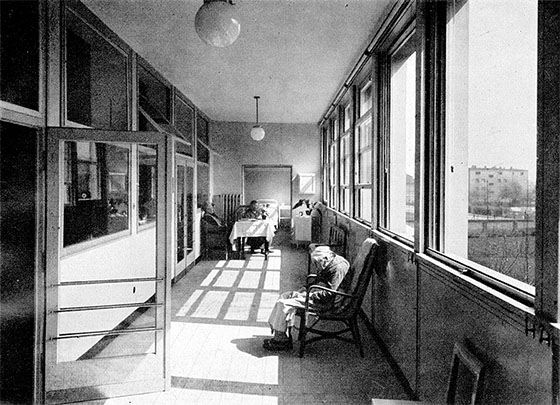
in Nosbisch 1930
History of People
Health insurances for Rödelheim´s hospital and almshouse
The members of Rödelheim´s three health insurances were entitled to be treated at hospital free of charge. In 1820 “Rödelheim´s Health Insurance for Single Jews” was founded. It had about 50 members and assets of approximately 15,000 Guilders. The chairman at this time was Leopold Fleisch, a butcher, who was also a member of the executive board of the hospital (cp. Dippel 1995). The “Jewish Funeral and Patients´ Assistance Fund” was also founded in 1820 and the “Jewish Patients´ Assistance Fund for Charity” in 1871 (cp. Dippel 1995). Another possibility for inexpensive treatment at Rödelheim´s hospital was the insurance by subscription issue through the employer. Such a received issue, printed by Rödelheim´s printer J. Lehrberg and Comp., bears the title “Subscription for Admission to Rödelheim´s Hospital for Farmhands, Craftsmen and Factory Workers – approved in Wiesbaden, 10th March 1875, the Royal District Administrator Rath”. In accordance with §1 of the statutes for admission to Rödelheim´s hospital of the Joseph and Hannchen May Foundation printed therein “the intention of the subscription is to effect the immediate admission to the hospital in case of illness, where help and care is granted to the patient until he has completely recovered.” The subscription issue could be ordered by employers and sold to their employees for 10 Pfennigs. This weekly contribution of 10 Pfennigs was receipted in the issue (cp. ISG Ffm: Foundation Department 312).
Female physicians, patients and residents
The only thing having come down from the first administrator of the hospital and almshouse is the name P. Wagner (cp. Trümpert 1881: 39). One of the first female residents seemed to have been Katharina Schaub. Pastor Trümpert reports on her in 1881: “Because it is so unusual, I report on a 97-year old woman being healthy in body and mind, who has found shelter in the hospital for several years. It is the widow [sic] Katharina Schaub, born on January 1, 1784” (cp. Trümpert 1881: 39).
In 1910 the previous practitioner, the medical officer Dr. Momberger, retired from the institution, and Theodor Katz took over from him. Dr. Katz was born in Kaiserslautern on January 16, 1882, had studied in Würzburg and completed his military service in 1908. In the same year he went on a longer trip to Brazil. After having been employed in Hamburg / Eppendorf, he now was in charge as assistant physician at the local hospital (cp. ISG Ffm: magistrate records V 339: 5). In a document from 1925 his position in Rödelheim is described as additional welfare service. He was obliged to visit the institution three times a week for which he received a basic remuneration of 50 Marks plus a local special surcharge (cp. ISG Ffm: magistrate records V 339: 51).
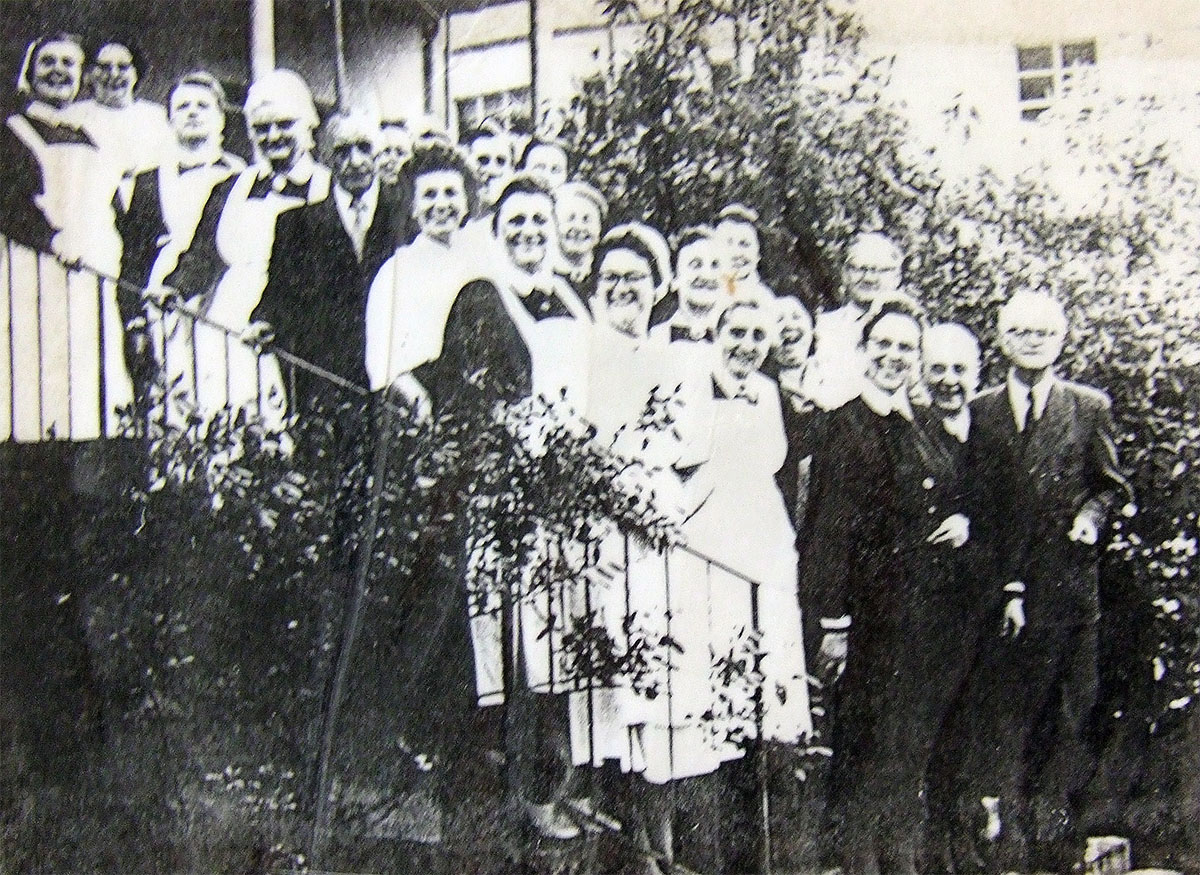
From: Ausstellung Dippel, 1995
A photo of the staff of the “old nursing home” has been preserved. The year when it was taken is unknown, but it probably shows the staff of the nursing home that existed inside the building from 1922. It can be concluded from the floor plans that at least a few of them seemed to have lived in the home.
Around 1930 Mrs. Julie Roger was the manageress of the home. She also chaired Frankfurt´s registered association for old-age welfare service (cp. ISG Ffm: magistrate records 339, April 30, 1930). Medical director was the medical officer Dr. Pfannmüller (cp. Frankfurt News April 29, 1930).
Up to which date and in which number Jewish residents used to live in the home could not be investigated. One note is from March 1937, when Frankfurt´s registered association for old-age welfare service states in an application to the magistrate that the home is “only occupied by German comrades” (ISG Ffm: Foundation Department 311-312: April 23, 1937). During the war the residents were joined by people who had lost their homes by air raids. Due to the bombing raids, a few nurses as well as some residents of the home were transferred to “Rheinhöhe im Rheingau” during the war (cp. ISG Ffm: magistrate records 3813: 81). The literature provides the names of the two head nurses, Anni Bohne and Mrs Satzinger. The care manager Bales reports of the head nurse Satzinger in April 1944 and states she has taken over a few guesthouses in Bad Salzhausen after having left Dornbuschheim when it was destroyed [see Budge-Home] and also been bombed out of her premises at 50 Gärtnerweg and Leerbachstrasse (ISG Ffm: air-raid protection 88).
Edgar Bönisch 2013
